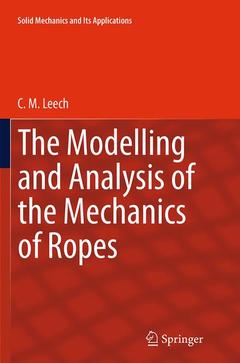The Modelling and Analysis of the Mechanics of Ropes, Softcover reprint of the original 1st ed. 2014 Solid Mechanics and Its Applications Series, Vol. 209
Auteur : Leech C.M.

This book considers the modelling and analysis of the many types of ropes, linear fibre assemblies. The construction of these structures is very diverse and in the work these are considered from the modelling point of view. As well as the conventional twisted structures, braid and plaited structures and parallel assemblies are modelled and analysed, first for their assembly and secondly for their mechanical behaviour. Also since the components are assemblies of components, fibres into yarns, into strands, and into ropes the hierarchical nature of the construction is considered.
The focus of the modelling is essentially toward load extension behaviour but there is reference to bending of ropes, encompassed by the two extremes, no slip between the components and zero friction resistance to component slip. Friction in ropes is considered both between the rope components, sliding, sawing and scissoring, and within the components, dilation and distortion, these latter modes being used to model component set, the phenomenon instrumental in rope proofing. The exploitation of the modelling is closed by the suggested modelling and analysis of component wear and life limitation and also of rope steady state heating. These will require extensive experimentation to extract the necessary coefficients, achievable by parallel testing of prototypes and similar structures.
This development is focused on the modelling and analysis of ropes and other similar structures. All the modelling is based on the Principle of Virtual Work and admissible modes of deformation. Finally this book is directed towards the various industries involved in design, manufacture and use of ropes, stays and other similar structures.
1 Introduction.- 2 Fibre Geometry and Fibre Mechanics.- 3 Component Path Geometries.- 4 Transversely Continuous Structures.- 5 Hierarchical Structures.- 6 Transversely Discrete Structures.- 7 Contact Force and Friction.- 8 Component Wear, Life and Heating.- Appendix - Tentative Scaling Relations.
The author graduated in aeronautical engineering from the Imperial College, London, and spent ten years with the Canadian Defence Research Board (DRB) working on various aspects of hypersonic dynamics and high speed impact. In this time he also studied at Toronto University for a MEng and PhD, sponsored by the DRB. He then went to Bristol University to work on the dynamics and aerodynamics of containers suspended below helicopters.
The next position was at UMIST (University of Manchester Institute of Science and Technology) as a lecturer and then as reader; at UMIST he was initially involved with impact dynamics, applied to nets and body armour. This developed into liaison and collaboration with the Textile Department at UMIST and involvement into cable dynamics and ultimately ropes. He was awarded the DSc. (Applied Mechanics) by Imperial College.
He was one of the directors involved in forming the company TTI (Tension Technology International Limited), and as a consultant was instrumental in undertaking various contracts in the modelling and assessment of rope mechanics and behaviour. He has since retired from UMIST and from TTI as a director but is still active as a consultant.
Date de parution : 09-2016
Ouvrage de 123 p.
15.5x23.5 cm
Date de parution : 12-2013
Ouvrage de 123 p.
15.5x23.5 cm



